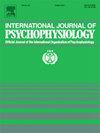Effects of target probability on motor preparation and execution
IF 2.6
3区 心理学
Q3 NEUROSCIENCES
引用次数: 0
Abstract
The aim of the present study was to assess the effects of motor target probability on the associations between pro-active motor preparation as reflected by negative slow potentials (NSPs), motor execution as reflected by response-related potentials (RRPs), and performance monitoring as reflected by correct response negativity (Nc). It was hypothesized that if ongoing increases/decreases in preparation induced by target expectation modulate motor execution and monitoring, there would be an association between the effects of motor target probability on NSPs and RRPs/Nc.
Electroencephalographic (EEG) signals were recorded in young adults while they produced simultaneous responses with the two hands to Go trials in auditory Go/NoGo tasks with different target probabilities (P = 0.15, P = 0.50, and P = 0.85). NSPs and RRPs were analyzed at the midline and bilateral motor regions. Nc was analyzed at medial frontal electrodes.
It was found that the effects of probability on NSPs were lateralized: At the left motor cortex NSPs were expressed for the low and high probabilities, mirroring response speeding, whereas at the right motor region NSPs were not pronounced for higher (P = 0.50 and P = 0.85) probabilities. Bi-lateral RRPs were larger for low- than equal- and high-probability targets and correlated positively with left-hemisphere NSPs but negatively with right-hemisphere NSPs. Nc did not depend on target probability.
The lateral and functional NSP/RRP asymmetry and their correlations suggest that the interaction between movement preparation and execution is modulated by hemispheric specialization in motor control such that movement execution in enhanced inhibition context is potentiated by the left hemisphere, and movement execution in response generation context is controlled by proactive inhibition in the right hemisphere. The effects of target probability on performance monitoring are not clearly demonstrated by Nc analysis in Go/NoGo tasks.
目标概率对运动准备和执行的影响。
本研究的目的是评估运动目标概率对负慢电位(NSPs)反映的主动运动准备、反应相关电位(rrp)反映的运动执行和正确反应负性(Nc)反映的表现监测之间的关联的影响。假设如果目标预期引起的准备的持续增加/减少调节运动执行和监测,那么运动目标概率对nsp和rrp /Nc的影响之间存在关联。在不同目标概率的听性Go/NoGo任务中,记录年轻人双手同时做出反应的脑电图(EEG)信号(P = 0.15,P = 0.50,P = 0.85)。在中线和双侧运动区分析nsp和rrp。在内侧额电极处分析Nc。结果发现,概率对NSPs的影响是横向的:在左侧运动皮层,NSPs在低概率和高概率下表达,反映了反应速度,而在右侧运动区域,NSPs在高概率下不表达(P = 0.50和P = 0.85)。双侧rrp在低概率靶点比等概率靶点和高概率靶点更大,与左半球NSPs呈正相关,与右半球NSPs负相关。Nc不依赖于目标概率。NSP/RRP的横向和功能性不对称及其相关性表明,运动准备和执行之间的相互作用是由运动控制的半球特化调节的,因此,在增强抑制环境下的运动执行由左半球加强,而在反应产生环境下的运动执行由右半球的主动抑制控制。在Go/NoGo任务的Nc分析中,目标概率对性能监测的影响并没有得到明确的证明。
本文章由计算机程序翻译,如有差异,请以英文原文为准。
求助全文
约1分钟内获得全文
求助全文
来源期刊
CiteScore
5.40
自引率
10.00%
发文量
177
审稿时长
3-8 weeks
期刊介绍:
The International Journal of Psychophysiology is the official journal of the International Organization of Psychophysiology, and provides a respected forum for the publication of high quality original contributions on all aspects of psychophysiology. The journal is interdisciplinary and aims to integrate the neurosciences and behavioral sciences. Empirical, theoretical, and review articles are encouraged in the following areas:
• Cerebral psychophysiology: including functional brain mapping and neuroimaging with Event-Related Potentials (ERPs), Positron Emission Tomography (PET), Functional Magnetic Resonance Imaging (fMRI) and Electroencephalographic studies.
• Autonomic functions: including bilateral electrodermal activity, pupillometry and blood volume changes.
• Cardiovascular Psychophysiology:including studies of blood pressure, cardiac functioning and respiration.
• Somatic psychophysiology: including muscle activity, eye movements and eye blinks.

 求助内容:
求助内容: 应助结果提醒方式:
应助结果提醒方式:


